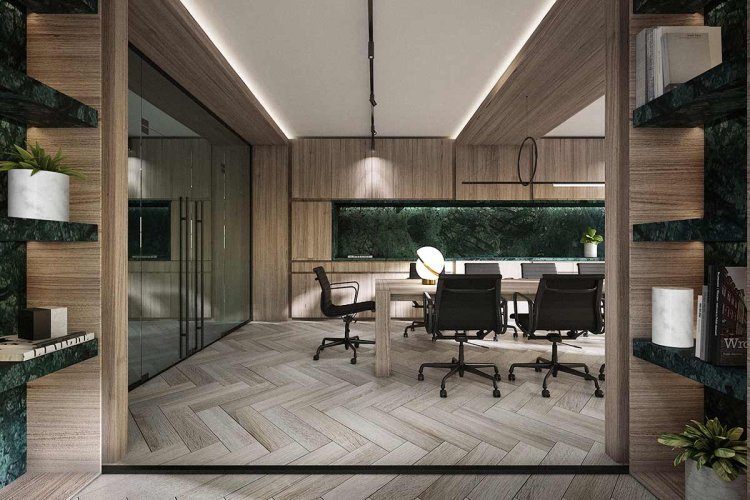Office Interior Design Space Trends Through the Decades
Learn about the office interior design space trends through the decades. Read the details on the blog.
Let's explore the evolution of office interior design space trends through the decades:
- 1900s-1920s: Classic Elegance
Offices during this period were characterized by grandeur and formality, with heavy wood furniture, intricate detailing, and ornate fixtures.
Dark wood paneling, plush upholstery, and traditional architectural elements were common features of office interiors, reflecting a sense of prestige and authority.
- 1930s-1950s: Modernization and Streamlining
The 1930s to 1950s saw a shift towards modernization and efficiency in office design.
Streamlined furniture designs, clean lines, and functional layouts became prevalent, reflecting the influence of modernist architecture and industrial design.
Offices were often designed to maximize natural light and airflow, with large windows and open-plan layouts becoming more common.
- 1960s-1970s: Space Age and Innovation
The 1960s and 1970s brought a period of experimentation and innovation in office design, influenced by the Space Age and counterculture movements.
Bold colors, geometric shapes, and futuristic motifs were popular, reflecting the era's fascination with technology and progress.
Open-plan offices and modular furniture systems became more widespread, promoting collaboration and flexibility in the workplace.
- 1980s-1990s: Corporate Modernism and Cubicles
The 1980s and 1990s saw the rise of corporate modernism and the widespread adoption of cubicles as a dominant office design feature.
Offices became more standardized and uniform, with cubicles providing individual workspaces while still allowing for a degree of privacy.
Technology integration became increasingly important, with offices incorporating computers, fax machines, and other electronic devices into their design.
- 2000s-2010s: Open Plan and Collaboration
The 2000s and 2010s brought a resurgence of open-plan offices and a focus on collaboration and communication.
Flexible layouts, modular furniture, and multipurpose spaces became key features of office design, allowing for easy reconfiguration and adaptation to changing work needs.
Sustainability and wellness also emerged as important considerations, with offices incorporating features like natural lighting, indoor plants, and ergonomic furniture to promote employee health and well-being.
- 2020s-Present: Hybrid Workspaces and Flexibility
The COVID-19 pandemic has accelerated trends towards remote work and hybrid workspaces, leading to a greater emphasis on flexibility and adaptability in office design.
Offices are being redesigned to accommodate both in-person and remote collaboration, with features like video conferencing equipment, touchless interfaces, and flexible seating arrangements becoming more common.
Biophilic design principles continue to influence office interiors, with an emphasis on incorporating natural elements like wood, stone, and greenery to create a sense of connection to the outdoors and promote employee well-being.
Throughout the decades, office interior design trends have evolved in response to changes in technology, workplace culture, and architectural styles, reflecting shifting priorities and values in the modern workplace.
Office interior design has come a long way, reflecting not just changing aesthetics but also evolving ideas about work and productivity. Here's a whistle-stop tour of some key trends through the decades:
- Early 1900s: The Efficiency Era
Think: Rows upon rows of identical desks bathed in harsh overhead lighting. This era borrowed from the principles of scientific management, prioritizing efficiency and control.
- 1950s & 1960s: Mid-Century Modern
Think: "Mad Men" vibes. This era saw a shift towards a more corporate image. Sleek furniture, chrome accents, and pops of bold color reflected a sense of optimism and prosperity.
- 1970s & 1980s: The Rise of the Cubicle
Think: Beige walls, fluorescent lights, and endless cubicles. This era prioritized practicality and affordability. Cubicles offered some privacy for computer work, which was becoming increasingly common.
- 1990s & Early 2000s: Open Floor Plans and the Dot Com Boom
Think: Beanbags, exposed brick, and bright colors. This era saw a shift towards collaboration and innovation. Open floor plans and unconventional furniture reflected a more casual and fast-paced work style.
- Mid-2000s to Today: Focus on Well-being and Flexibility
Think: Ergonomic furniture, natural light, and biophilic design elements like plants and natural materials. This era reflects a growing understanding of the link between workplace design and employee well-being. There's a focus on creating a variety of workspaces to suit different tasks and preferences, with a nod towards comfort and a connection to nature.
Looking Ahead: The Future of Office Design
The future of office design is likely to continue to evolve alongside technology and our understanding of work. Here are some potential future trends:
Activity-Based Working: Workspaces designed for specific activities, like focused work, collaboration, or relaxation.
Smart Offices: Technology integration to optimize space utilization, temperature control, and lighting.
Sustainability: A focus on using eco-friendly materials and creating energy-efficient workspaces.
The ideal office design will depend on the specific company culture and needs. But by understanding the history and future trends of office design, businesses can create workspaces that foster productivity, creativity, and employee well-being.
What's Your Reaction?












![Wireless Connectivity Software Market Size, Share | Statistics [2032]](https://handyclassified.com/uploads/images/202404/image_100x75_661f3be896033.jpg)



